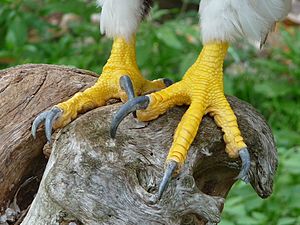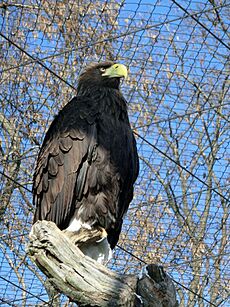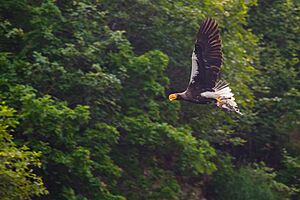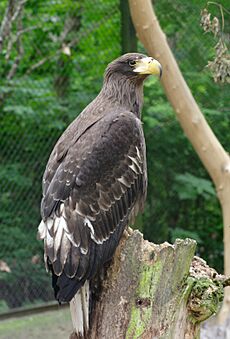Steller's sea eagle facts for kids
Quick facts for kids Steller's sea eagle |
|
|---|---|
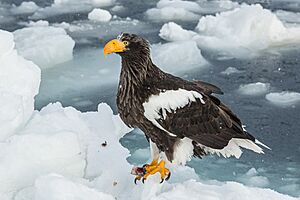 |
|
| A Steller's sea eagle near Rausu, Hokkaido, Japan | |
| Conservation status | |
| Scientific classification | |
| Genus: |
Haliaeetus
|
| Species: |
pelagicus
|
 |
|
| breeding only
resident all year winter only vagrant range |
|
| Synonyms | |
|
|
The Steller's sea eagle (Haliaeetus pelagicus) is a very large bird of prey. It is also known as the Pacific sea eagle or white-shouldered eagle. This powerful eagle belongs to the family Accipitridae. Peter Simon Pallas first described it in 1811. There are no known subspecies of this eagle.
Steller's sea eagles have dark brown feathers with bright white wings and tail. They have a large yellow beak and strong yellow talons. These eagles are usually the heaviest eagles in the world. They can weigh from about 5 to 10 kilograms (11 to 22 pounds). Female Steller's sea eagles are larger than males. This eagle lives along the coasts of northeastern Asia. You can find them in Russia, Korea, Japan, China, and Taiwan. They mostly hunt fish and water birds. The Kamchatka Peninsula in Russia has many of these eagles. About 4,000 live there. The Steller's sea eagle is listed as a vulnerable species. This means it needs protection.
Contents
What is a Steller's Sea Eagle?
Naming the Steller's Sea Eagle
The Steller's sea eagle was first named Aquila pelagica in 1811. This was done by a Prussian naturalist named Peter Simon Pallas. The name pelagica comes from an Ancient Greek word. It means "of the open sea" or "ocean". Later, other naturalists gave it different names. These included "white-winged eagle" and "emperor falcon". In 1849, George Robert Gray moved it to the genus Haliaeetus.
The official name, "Steller's sea eagle," honors the German naturalist Georg Wilhelm Steller. People also call it Steller's fish eagle or Pacific sea eagle. In Russia, it's called "sea eagle" or "white-shouldered eagle." In Japan, it's "ō-washi," meaning "large eagle." Koreans call it "chamsuri," or "true eagle." In Chinese, it's "hǔtóu hǎidiāo," which means "tiger-headed sea eagle."
Understanding Eagle Family Trees
Scientists studied the genes of Steller's sea eagles. They found that these eagles separated from the bald eagle and white-tailed eagle families a long time ago. This was about 3 to 4 million years ago. All three of these eagle types have yellow eyes, beaks, and talons. Their closest relative is Pallas's fish eagle. But Pallas's fish eagle looks different.
Rare Dark Steller's Sea Eagles
Normally, Steller's sea eagles have white patches. But there is a very rare dark version. This dark version was once thought to be a separate type of eagle. It was called H. p. niger. These dark eagles have no white feathers except for their tail. One dark female was born in captivity in Germany in 2001. Her parents had normal colors. This showed that the dark version is just a rare color variation. It is not a separate subspecies.
How Big are Steller's Sea Eagles?
Steller's sea eagle is the biggest bird in its group, Haliaeetus. It is also one of the largest birds of prey overall. Female eagles are heavier than males. Females weigh from 6.2 to 9.5 kg (13.7 to 20.9 lb). Males are lighter, weighing 4.9 to 6.8 kg (10.8 to 15.0 lb). On average, a Steller's sea eagle weighs about 7.75 kg (17.1 lb).
These eagles are very long. Their total length can be from 85 to 105 cm (33 to 41 in). Males average about 89 cm (35 in) long. Females average about 100 cm (39 in) long. This makes them slightly shorter than the harpy eagle. They are also about 65 mm (2.6 in) shorter than the Philippine eagle.
Wingspan of the Steller's Sea Eagle
The wingspan of a Steller's sea eagle is huge. It ranges from 1.95 to 2.50 meters (6 ft 5 in to 8 ft 2 in). Their average wingspan is about 2.13 meters (7 ft 0 in). Some reports say they can have even larger wingspans. Some unconfirmed records suggest wingspans up to 2.8 meters (9 ft 2 in). If true, this would make it the eagle with the largest wingspan.
Unique Features of the Steller's Sea Eagle
Steller's sea eagles are special. They are the only sea eagles with a yellow beak, even when they are young. They also have 14 tail feathers. Most other eagles have 12.
Feet and Beak of the Steller's Sea Eagle
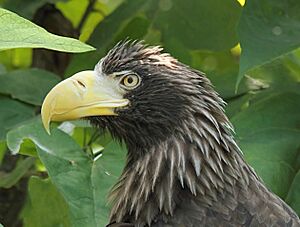
Like other sea eagles, their legs and tail are fairly short. Their feet are strong and have bumpy skin called spicules. These spicules help them hold onto slippery fish. Their talons are shorter and more curved than those of eagles that hunt mammals. This design is perfect for catching fish.
Their beak is very large. It is likely the largest beak of any living eagle. It is even bigger than the Philippine eagle's beak. This huge beak helps them tear apart their prey.
What Does a Steller's Sea Eagle Look Like?
Adult Steller's sea eagles are mostly dark brown or black. They have very clear white patches. These white parts are on their wings, thighs, and tail. Their tail is shaped like a diamond and is quite long. The bright colors of adult eagles might help them recognize each other. Their eyes, beak, and feet are all yellow.
When they are newly hatched, chicks have soft white down. This quickly turns smoky brown-grey. Young eagles have dark brown eyes and a blackish-brown beak. As they grow, their tail mottling decreases. Their body and wing feathers get a bronze color. Their eyes and beak also become lighter. They get their full adult look when they are four or five years old. Young dark morph eagles look like young normal eagles. The difference only shows when they get their adult feathers.
It can be hard to tell young Steller's sea eagles apart from white-tailed eagles. White-tailed eagles live in the same areas. But Steller's sea eagles are bigger and have a much larger beak. Their body feathers are also darker and more even in color. In flight, their wings look more like paddles. The white-tailed eagle's wings look more square.
What Sounds Do Steller's Sea Eagles Make?
Steller's sea eagles make a deep barking sound, like "ra-ra-ra-raurau." When they are fighting, their call is similar to a white-tailed eagle's, but deeper. During mating season, they make loud, deep calls that sound like gulls.
Where Do Steller's Sea Eagles Live?
Steller's sea eagles breed in Russia. Their breeding areas include the Kamchatka Peninsula and the Sea of Okhotsk coast. They also breed near the Amur River, and on Sakhalin and the Shantar Islands. Many eagles fly south for winter. They go to Korea, Japan, and China. Most spend winter in the southern Kuril Islands (Russia) and Hokkaidō (Japan).
Steller's sea eagles usually stay close to their home areas. They don't wander as far as white-tailed eagles. But some have been seen far away. They have appeared in North America, including Alaska and even Texas. One eagle was seen in several places in eastern Canada and the US. It was spotted in Nova Scotia, Massachusetts, and Maine. It was even seen in Newfoundland. Inland in Asia, they have been seen in Beijing and Yakutsk. They have also flown as far south as Taiwan.
These large eagles likely evolved in a specific cold zone. This zone was along the northeastern Asian coasts. It moved with the ice ages. They build their nests high up. They choose large rocky cliffs or tall trees near the coast. They also nest along big rivers with old trees. They prefer forests with Erman's birches, larches, alders, willows, and poplars. Some eagles that nest by the sea might not migrate. When and how far they migrate depends on ice conditions and how much food is available.
In Kamchatka, eagles spend winter in forests and river valleys near the coast. Most wintering birds there are adults who live there all year. Eagles that migrate fly south to Japan. They winter in rivers and wetlands. Sometimes they go to mountains instead of the coast. In winter, ice on the Sea of Okhotsk pushes thousands of eagles south. The ice reaches Hokkaido in late January.
Eagle numbers are highest in the Nemuro Strait in late February. On Hokkaido, eagles gather in coastal areas and near lakes. Many white-tailed eagles also gather there. Steller's sea eagles leave between late March and late April. Adults usually leave before the younger birds. Migrating eagles tend to follow coastlines. They usually fly alone. If they fly in groups, they are often 100 to 200 meters (330 to 660 ft) apart. On Kamchatka, most migrating birds are young eagles. They are also sometimes seen flying over the ocean or resting on sea ice in winter.
What Do Steller's Sea Eagles Eat?
Steller's sea eagles mainly eat fish. In rivers, they love salmon and trout. They especially like pink salmon and chum salmon. They also eat grayling and three-spined stickleback. Pink salmon weigh about 2.2 kg (4.9 lb) and chum salmon about 5 kg (11 lb). But Steller's sea eagles often catch fish weighing up to 6 to 7 kg (13 to 15 lb). Along the coast, they eat fish like Bering wolffish and smooth lumpfish. Like most Haliaeetus eagles, they hunt fish in shallow water. Many of these eagles gather where salmon are spawning. This is because there is a lot of food.
In Kamchatka, groups of up to 700 eagles have been seen. But smaller groups are more common. In summer, they feed young eagles live fish. These fish are usually 20 to 30 cm (7.9 to 11.8 in) long. Parents usually catch two or three fish for their young each day. In autumn, many salmon die after spawning. Then, the eagles eat dead fish more often. These dead fish are the main food for eagles that stay in unfrozen rivers during winter.
On Hokkaido, eagles are drawn to many Pacific cod. These fish are plentiful in the Rausu Sea in February. This fish supply helps support the eagles. Alaska pollock is also a very important food for wintering eagles in Japan. These eagles can walk close to fishermen. This happens when both are catching fish in winter. But they only do this with fishermen they know. They stay away from strangers.
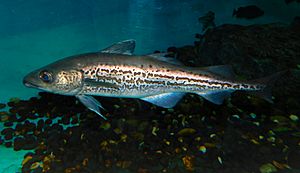
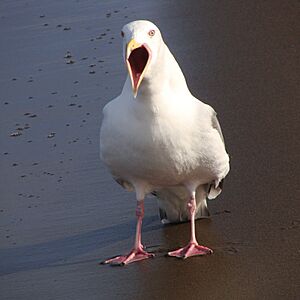
Fish make up about 80% of the diet for eagles nesting near the Amur River. In other places, other animals are eaten almost as much. Along the coast and in Kamchatka, water birds are common prey. They eat ducks, geese, swans, cranes, herons, and gulls. They especially like slaty-backed gulls. They also hunt murres, kittiwakes, and cormorants. In Russia, they eat upland grouse. These birds are not usually hunted by other sea eagles. They also hunt owls, crows, and ravens. Sometimes, they even catch small songbirds. One eagle was seen eating a great albatross. This is a rare bird from the Southern Ocean.
Steller's sea eagles also eat other things. They might eat mammals like hares. They also eat crabs, mussels, worms, and squid. They hunt meat-eating mammals. These include sables, American minks, Arctic foxes, red foxes, and small domestic dogs. Smaller mammals like voles are also eaten. They often eat carrion (dead animals) in winter. About 35% of eagles in Japan eat dead sika deer left by hunters. Young eagles might visit slaughterhouses for scraps. These eagles have also been seen hunting young seals.
Steller's sea eagles usually hunt from a perch. They sit on a tree or rock 5 to 30 meters (16 to 98 ft) above the water. They also hunt while flying in circles 6 to 7 meters (20 to 23 ft) high. Once they spot prey, they dive to catch it. Sometimes, they stand in shallow water. They grab passing fish from a sandbank or ice-floe. Steller's sea eagles are known to be more "aggressive, powerful, and active" than bald or white-tailed eagles.
When many eagles feed together, they often steal food from each other. This is called kleptoparasitism. It helps them get food when there is a lot available. Young eagles steal food as much as adults. But adults attack young eagles more often. The bold colors of adult eagles might help them form feeding groups. Outside breeding season, these eagles probably sleep together near their feeding spots. In winter, when salmon die, Steller's sea eagles may feed with smaller golden eagles and white-tailed eagles.
Sometimes, a smaller eagle might steal fish from a Steller's sea eagle. This happens if the Steller's eagle is distracted. But usually, the Steller's sea eagle uses its size to dominate. It will bear down on smaller eagles with its mass and large beak. Sometimes, the three eagle species (Steller's, golden, white-tailed) feed near each other peacefully. In other areas, where food is scarce, eagles might fight more. White-tailed eagles and golden eagles have even killed each other in Scotland. Steller's sea eagles may also try to steal fish from ospreys.
Steller's Sea Eagle Life Cycle and Reproduction
Steller's sea eagles build large nests. These nests are made of twigs and sticks. They can be up to 1.5 meters (4.9 ft) high and 2.5 meters (8.2 ft) wide. They usually place nests high in trees or on rocky cliffs. Nests are often 15 to 20 meters (49 to 66 ft) above the ground. Some nests are as high as 45 meters (148 ft). They often build several nests. These alternate nests are usually within 900 meters (3,000 ft) of each other.
Mating displays happen between February and March. This usually involves soaring flights above the nesting area. It was once thought that eagle pairs stayed together for life. But studies show that some chicks are related to chicks from other nests. This might mean that some eagles have more than one mate.
Steller's sea eagles lay greenish-white eggs around April or May. The eggs are about 78 to 85 mm (3.1 to 3.3 in) tall. They are 57.5 to 64.5 mm (2.26 to 2.54 in) wide. Each egg weighs about 160 grams (5.6 oz). A clutch can have one to three eggs. Two eggs are most common. Usually, only one chick survives to become an adult. But sometimes, all three can fledge. Eggs hatch after about 39 to 45 days. The chicks are born helpless and covered in whitish down. The young eagles learn to fly in August or early September. They get their adult feathers at four years old. But they usually don't start breeding until they are five or six.
Threats to Young Eagles
Eggs and very small chicks can be eaten by tree-climbing mammals. These include sables and ermines. Birds like corvids (crows, ravens) also prey on nests. These small predators try to be sneaky. If the parent eagles catch them, they will kill them. Once the young eagles are almost adult size, few predators can harm them. In one rare case, a brown bear ate a young eagle from a nest on a rock. But this is very unusual. Young eagles in tree nests are probably safe from predators. No other large meat-eating mammals in the eagle's range can climb trees.
Many eggs are lost due to predators or nests falling apart. Only about 45% to 67% of eggs successfully become adults. Up to 25% of nestlings might be lost. But once fully grown, the Steller's sea eagle has no natural predators.
Conservation Status: Protecting Steller's Sea Eagles
The IUCN lists Steller's sea eagles as a vulnerable species. This means they are at risk. They are protected by law. In Japan, they are a national treasure. In Russia, they mostly live in protected areas. But they still face many dangers. These include changes to their habitat and pollution. Overfishing also reduces their food supply. The current population is estimated at 5,000 birds. This number is decreasing.
Heavy flooding has also caused problems. This might be due to climate change. Floods made it hard for parents to catch fish for their young. This led to almost no chicks surviving in some Russian rivers. People in Russia still hunt these birds. This is because the eagles sometimes steal furbearers from trappers. In some areas, eagles in Hokkaido eat deer carcasses left by hunters. This exposes them to lead poisoning from hunting bullets.
In Kamchatka, 320 pairs of eagles have been recorded. Over 1,200 pairs breed in the Koryakan mountains. At least 1,400 young eagles are there. About 500 pairs live on the Okhotsk coast in Khabarovsk. Another 100 pairs are on the Shantar Islands. About 600 pairs live in the lower Amur region. Around 280 pairs are on Sakhalin Island. A few are on the Kurile Islands. The total breeding population is about 3,200 pairs. Up to 3,500 birds may winter in Kamchatka. Another 2,000 may be on Hokkaido. Overall, the future for the species looks good. Their main wintering areas still have enough food.
|




